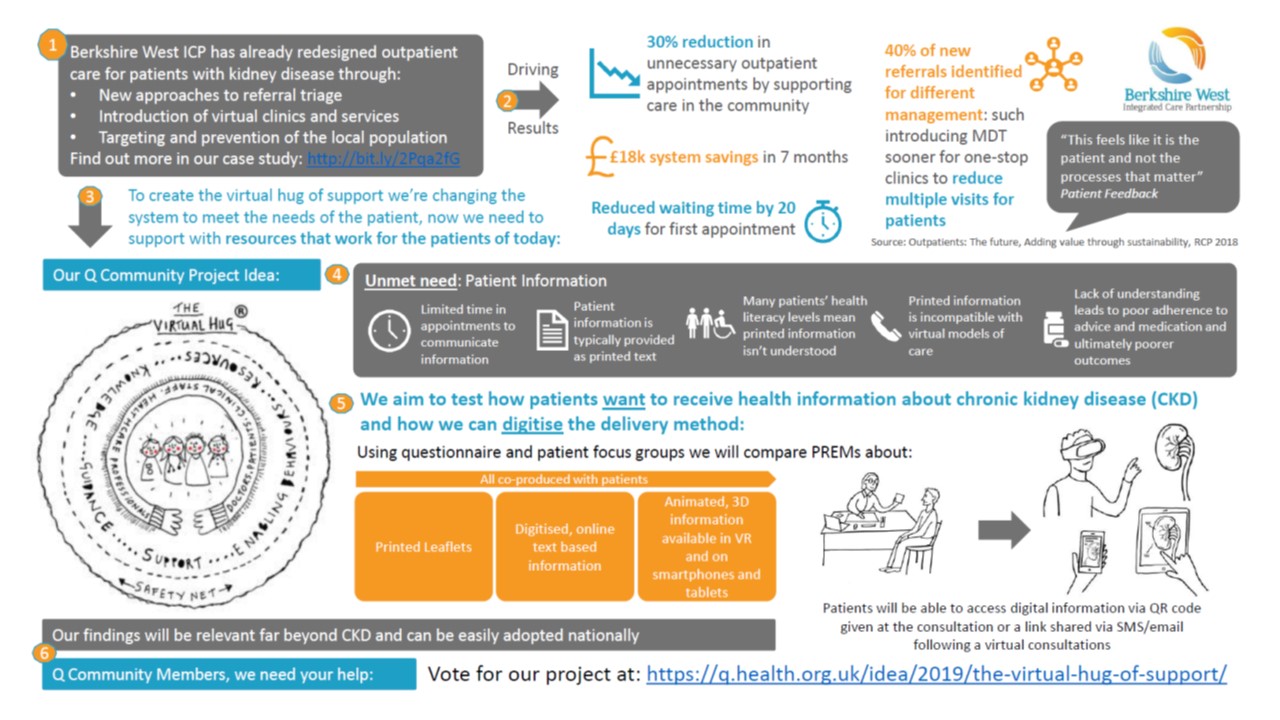As the pandemic kicked off so did we, in testing out different models of how patients might experience information about their health condition. In this case, chronic kidney disease, through work co-designed with patients and funded through Q Exchange. We’re now working on expanding these successful solutions provided so far, ranging from written information to immersive 360 video and/or virtual reality.
Why we did this
Patients can struggle to remember information that is provided to them during medical consultations; with studies finding 40-80% is forgotten immediately. In an era of growing patient empowerment to be involved in healthcare decisions, takeaway information leaflets can lead to a better understanding of their health or condition. However, a significant number of patients struggle to understand written information about their health due to health literacy and language barriers; this is a growing concern as we try to tackle health inequality and inequity.
The aim of our project was to evaluate how patients best understand and want to consume health information about their chronic kidney disease (CKD). We consulted with patients to produce easy-to-understand CKD information in two formats:
- written information with diagrams
- immersive, interactive animated digital information
Given the incompatibility of paper-based leaflets with virtual consultations, we also wanted to test the acceptability to patients of delivering this information digitally and remotely via their smartphones, tablets and in virtual reality alongside our virtual OPD and GP consultations.
A multi-professional group worked with our patient leaders to co-design, shape and influence the content, format and implementation.
What we have done so far
Despite the initial challenges brought about by COVID-19, we have:
- developed and co-created a patient-friendly curriculum for CKD and an accompanying questionnaire for evaluation
- designed a patient information leaflet for both print and online access
- delivered an avatar-led, interactive patient information programme, including prototyping, user testing and full programme development
- released this into the Healthinote platform for patients to access the content remotely
- shared all versions of the CKD content with patients to collect their feedback through questionnaires
- and analysed the data and initial questionnaire responses collected to gain insights into patient’s preferences.
The results
Patients using the interactive, avatar-led programme engaged with it for an average of 7 minutes and 1 second per session, which is considerably higher than the industry standards for patient information websites (typically between 1-2 minutes). From this, we can begin to deduce that interactive programmes capture the attention of patients for longer.

What we are doing next
We are investing in providing this resource in four different languages (Nepalese, Punjabi, Urdu & Polish), as well as the development of a similar resource for Acute Kidney Injury.
Learning along the way
Our cross-functional team with representation from primary care clinicians, secondary care clinicians, patients, the trust patient information manager and Cognitant Group – an external digital health technology partner bringing medical writing, animation and project management expertise – have all been significant contributors to this project. Technology has been a big enabler, both as a route to provide interactive education to our patients even when seeing them remotely, and also to connect us as a team.
Having patient representatives as part of the project working group was integral in helping to design materials suitable for the needs of patients
Nearly 90% of patients that used the CKD education materials produced for this project said that this information helped them to know more about their chronic kidney disease. We believe the key to this result was our engagement with patients in the design process of our solutions. Having patient representatives as part of the project working group was integral in helping to design materials suitable for the needs of patients.
The challenges we faced
We experienced some key challenges to our project. Firstly, the technology to send the resources to patients digitally in secondary care was lacking. Primary care colleagues were able to share the resource through SMS systems but in secondary care, we were reliant on posting information. The next key step is to explore integration with secondary care systems, for example, the use of the digital system for patients to receive communication or view their results such as Patient View.
We also found it challenging to get patients to provide feedback by completing the accompanying questionnaires. In particular, the quantity of digital feedback is lower than we had hoped to gather. Approximately, 11% of all patients who sent the information responded with paper-based questionnaires that were provided with a prepaid envelope, with the majority of those using written information only.
The feedback via the online questionnaire was low and we plan to use a different approach for the next phase of this project. This was a key learning for our project team and as we move forward; we hypothesise that questionnaires in digital content would deliver a better response rate if they are set up to feel part of the interactive experience, with questions interspersed throughout, rather than a questionnaire at the end.
The app-based approach is a barrier for some patients with CKD, particularly those in older age groups. Of those who only used the written information, three patients did also state in their questionnaire responses that they do look for health information online even though they did not access the app. This suggests that a web-based version of the content would improve accessibility for some patients.
Find out more and keep up with the latest on The virtual hug of support project via the project page.